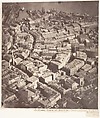Boston, as the Eagle and the Wild Goose See It
James Wallace Black American
Not on view
After Southworth and Hawes, the partnership of John Whipple and James Black was the most important in Boston. Black's career began humbly in 1845 as chief plate polisher in two local daguerreian studios. By 1852 he was apprenticed to Whipple, and within four years he was a partner in the firm. Between 1857 and 1860, Black managed the business single-handedly, while Whipple completed a three-year scientific exploration of celestial bodies at the Harvard College Observatory. Less interested in astronomy or abstract science, Black left Whipple in 1859 to focus the camera on his own planet.
Best known for his photographs of Boston after the devasting fire of 1872, Black launched his solo career in 1860 with the production of a series of aerial photographs taken from Samuel King's hot-air balloon the Queen of the Air. Black's views of Boston were the first aerial photographs made in America; two years earlier the Frenchman Nadar had made history making similar views of Paris.
Black's photographs caught the attention of Oliver Wendell Holmes, a poet and professor of medicine at Harvard, who gave this photograph its title. In July 1863, Holmes wrote in the Atlantic Monthly: "Boston, as the eagle and wild goose see it, is a very different object from the same place as the solid citizen looks up at its eaves and chimneys. The Old South [Meeting House] and Trinity Church [left center and lower right] are two landmarks not to be mistaken. Washington Street [bottom] slants across the picture as a narrow cleft. Milk Street [left center] winds as if the old cowpath which gave it a name had been followed by the builders of its commercial palaces. Windows, chimneys, and skylights attract the eye in the central parts of the view, exquisitely defined, bewildering in numbers...As a first attempt [at aerial photography] it is on the whole a remarkable success; but its greatest interest is in showing what we may hope to see accomplished in the same direction." Only two years later the Union Army would use balloon photography to spy on Confederate troops during the Peninsular Campaign in Virginia.
Due to rights restrictions, this image cannot be enlarged, viewed at full screen, or downloaded.

